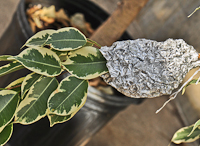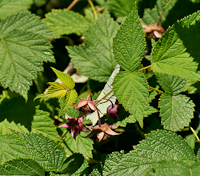|
 |
|
 This is an easy way to
reproduce plant. In fact, sometimes all you need is to
have a piece of a stem fall onto the ground and it will
sprout roots. Brambles do this all of the time. This is an easy way to
reproduce plant. In fact, sometimes all you need is to
have a piece of a stem fall onto the ground and it will
sprout roots. Brambles do this all of the time.
As a conscious effort by gardeners, layering can be
done in several ways. It involves the following steps:
- Select a long stem that can be bent down to the
soil.
- Make a small cut or notch in the stem to form a
wound.
- An optional step would be to powder the open
wound with some type of rooting
hormone.
- Bend the stem down onto the surface of the bare
soil.
- Place a rock or use some other method to keep
the wound in contact with the soil.
- Wait a few weeks or a month to see if roots
develop at the site of the wound.
- When roots have been established, cut the branch
above wound. However, do not move the plant yet. It
is always better to leave the new plant in the
ground for a growing season so that it establishes a
larger root system.
- Transplant your new plant.
 For the process to work
best, the soil must be warm. So, this is something that
is best accomplished in spring as soon as the soils are
50 degrees or more. Also, moisture is important so you
need to water the soil frequently. A layer of mulch may
also help to conserve the moisture. For the process to work
best, the soil must be warm. So, this is something that
is best accomplished in spring as soon as the soils are
50 degrees or more. Also, moisture is important so you
need to water the soil frequently. A layer of mulch may
also help to conserve the moisture. |
|
Types of Layering |
-
Tip Layering - Plants
with long stems such as blackberries, raspberries or
forsythia
will naturally bend over and have their tips
touching the ground. Many times all that is
necessary is to disturb the soil and push the tip
into the ground. Place a rock on it and before long,
new roots will develop.
-
Simple Layering -
This is the method described above where you wound
the stem to encourage root development.
-
Serpentine Layering -
Many vines such as wisteria,
clematis and others can
be layered by laying the vine along the ground and
covering it with soil in several places.
-
Mound Layering - On
some trees, new growth emerges from the base of the
trunk called suckers. If soil is mounded up to cover
the bottom 4 to 6 inches of these suckers, new roots
may develop resulting in new trees.
|
|
While layering can be an easy way to propagate certain
woody ornamental plants, be aware that it will not work
on all species. Some of the easier plants to layer would
include Bittersweet (Celastrus),
Deutzia (Deutzia),
Wintercreeper
(Euonymus),
Forsythia
(Forsythia),
Privet
(Ligustrum),
Honeysuckle (Lonicera),
Mockorange (Philadeiphus),
Rose (Rosa),
Spirea (Spiraea),
Viburnum
(Viburnum)
and Weigela
(Weigela). |
|



